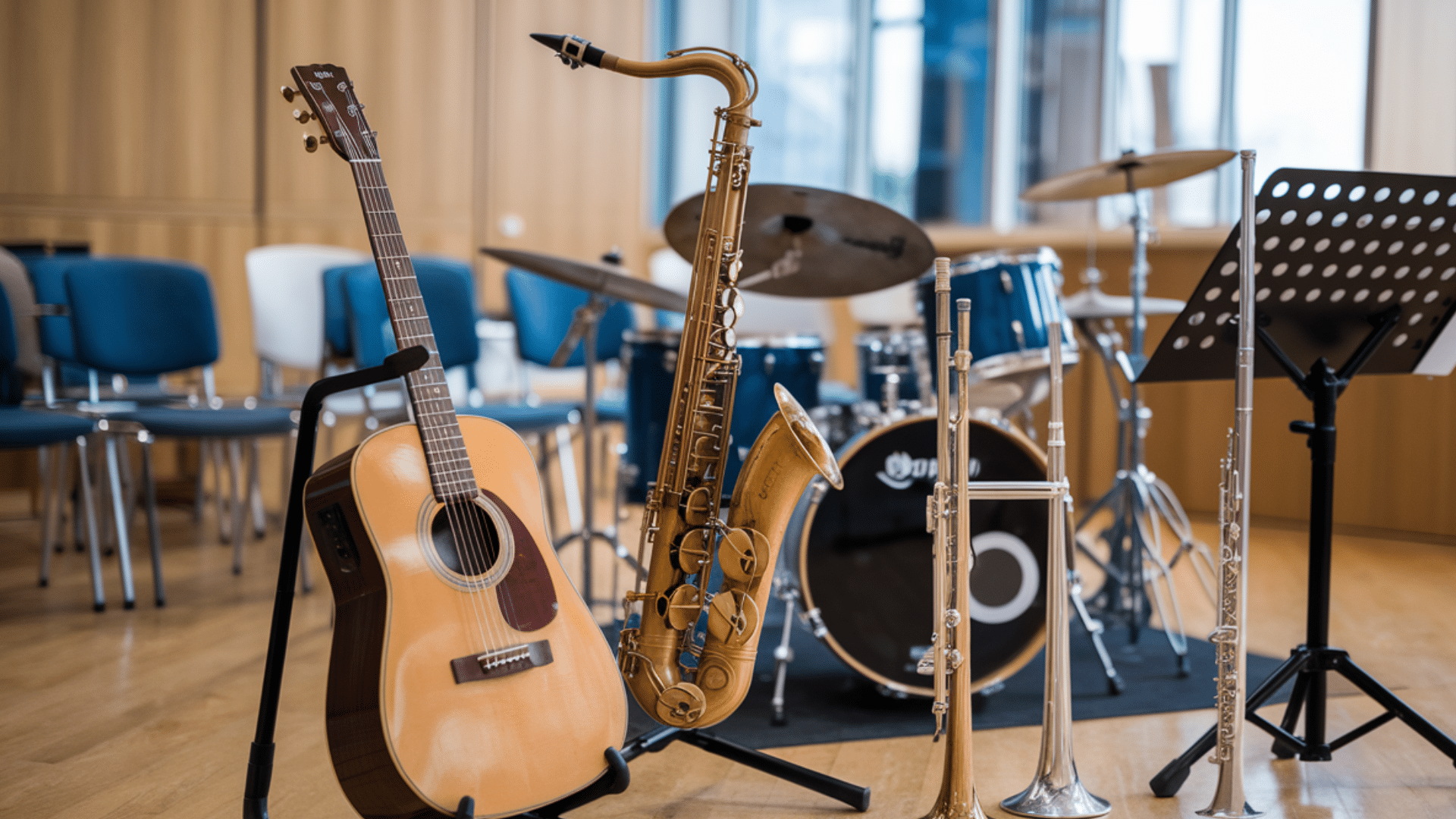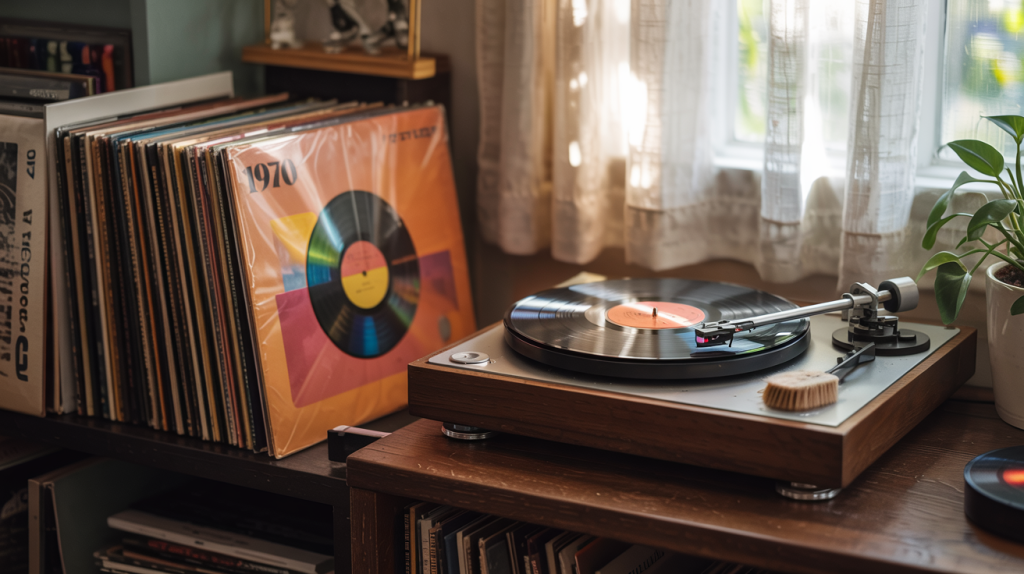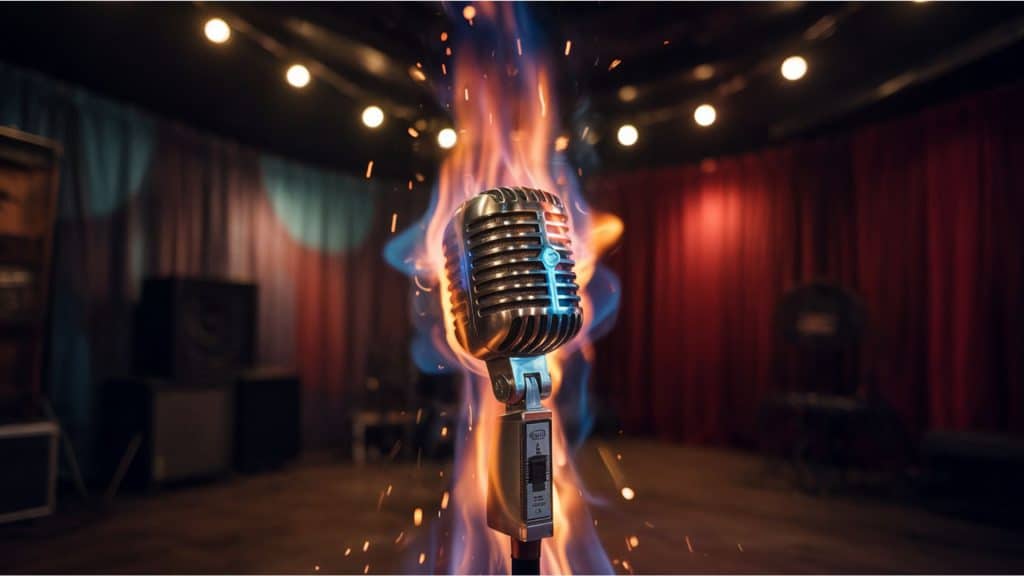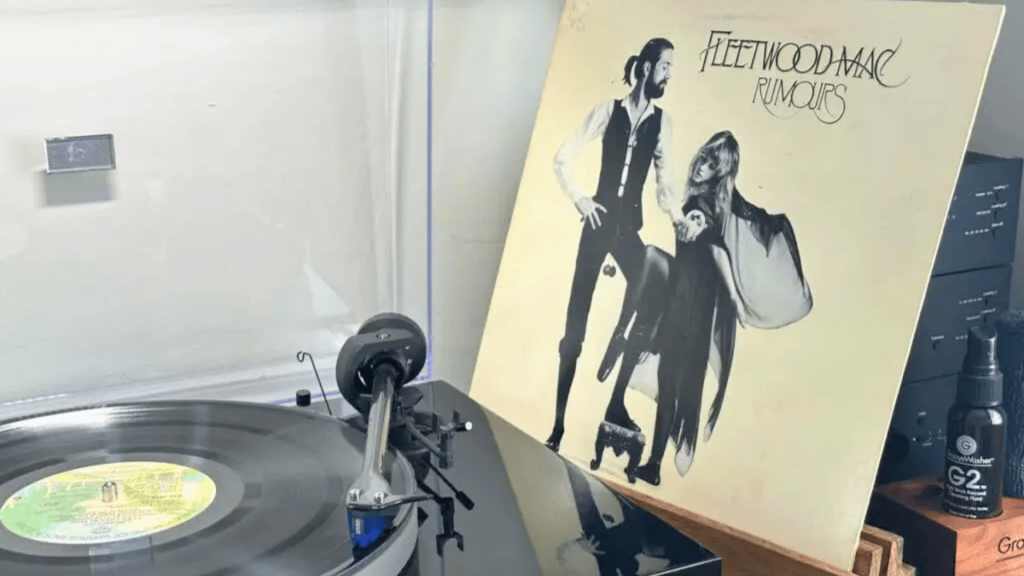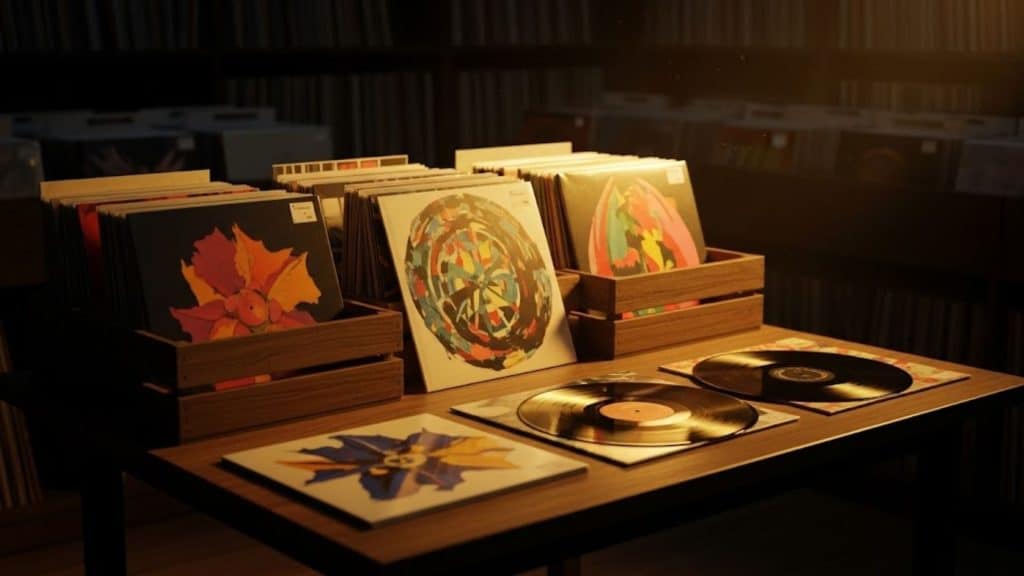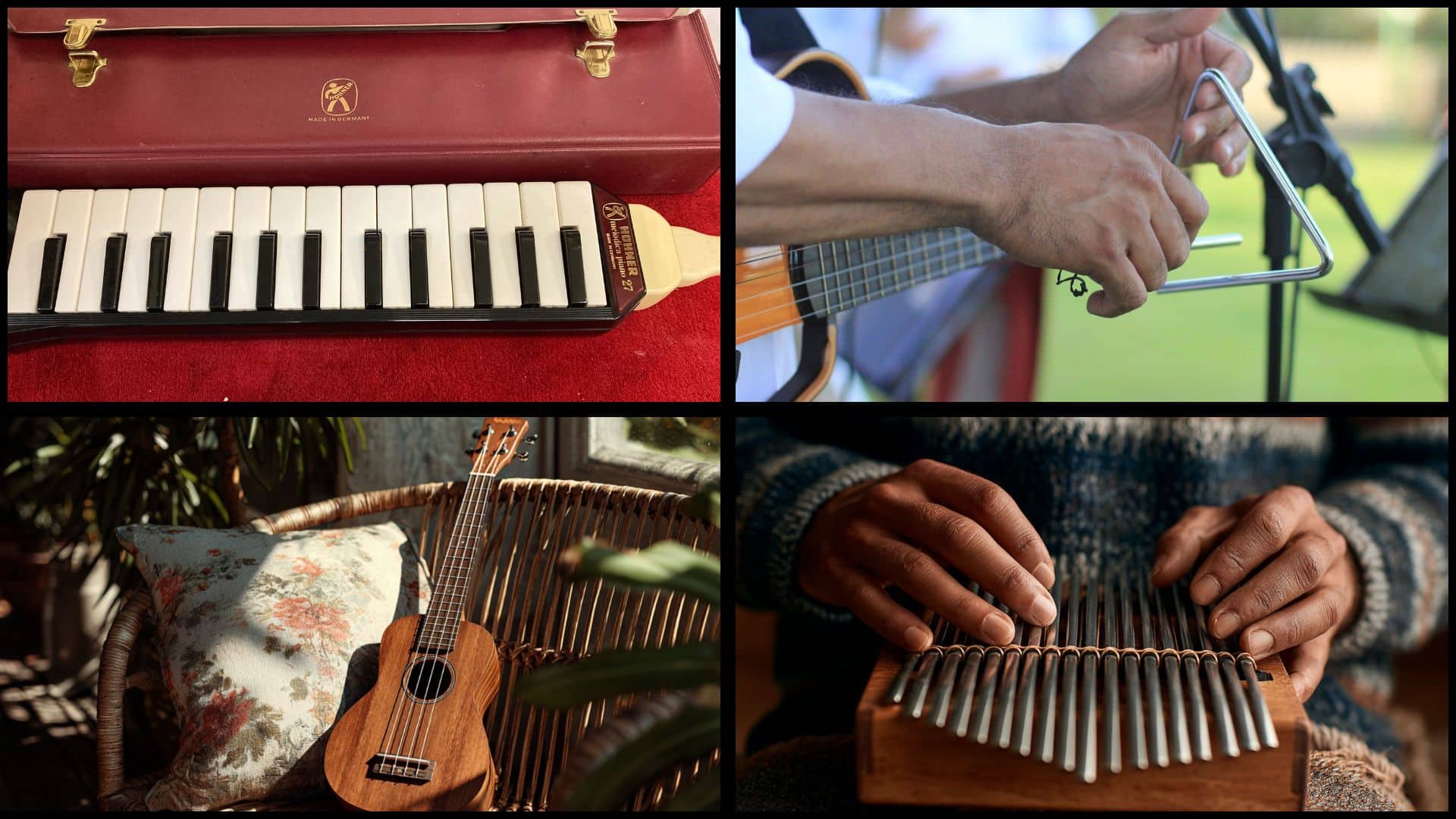Have you ever stopped and thought, “How do all these instruments make such different sounds?” I used to wonder the same thing.
If you’re like me, you’ve probably heard drums, guitars, flutes, or pianos and felt curious. What makes each one sound the way it does? That’s what this guide is for.
I’m going to break down the types of musical instruments in a way that’s super easy to understand. I’ll walk you through how they’re grouped and what sets them apart.
By the end, you’ll not only know more, you’ll see music with fresh eyes. Which instrument do you think will grab your attention first?
How are Musical Instruments Classified?
Musical instruments can be sorted in more than one way, but the two most common systems are the Western classification and the Hornbostel–Sachs system.
In the Western way, instruments are grouped into four basic types: strings, woodwinds, brass, and percussion. This method is simple and is mostly used in school bands and orchestras.
The Hornbostel–Sachs system goes a bit deeper. It looks at how each instrument makes sound. This system has five main groups: idiophones (like cymbals), membranophones (like drums), chordophones (like violins), aerophones (like flutes), and electrophones (like electric guitars).
Besides these systems, there are other ways people group instruments. Some go by the materials used, like wood or metal. Others focus on the origins of the instruments, such as African drums or Indian sitars.
These details help show how music is shaped by culture and history. It’s not just about sound, and it’s also about story and tradition.
The Main Types of Musical Instruments Explained
Musical instruments come in many shapes and sounds, but they all fall into a few main types. Let’s look at each one and see how they create the music we hear every day:
1. String Instruments
These instruments make sound by vibrating strings. You can play them by plucking, strumming, bowing, or tapping. Each one has its own feel and sound, from sharp and bright to deep and rich.
Bowed Strings
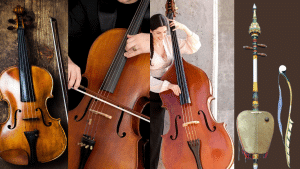
These instruments are played with a bow that moves across the strings to make sound. They can also be played by plucking. Bowed strings are known for their smooth, flowing tones and are often used in classical and folk music.
Violin: The violin is the smallest and highest-pitched instrument in the string family. It’s held under the chin and played with a bow. It’s known for its bright, sharp sound and often plays the main melody in classical music and orchestras.
Rebab: The rebab is an old string instrument found in parts of Asia and the Middle East. It’s usually played with a bow and has a soft, emotional sound. It’s often used in traditional music and storytelling, giving a unique voice to ancient songs.
Cello: The cello is much larger than a violin or viola and is played while sitting down. It rests on the floor with a spike called an endpin. Its tone is rich and deep, often used for emotional solos and strong background music.
Double Bass: The double bass is the biggest string instrument. It stands on the floor and can be played while sitting or standing. It makes the lowest sounds in the group. You’ll hear it in orchestras, jazz bands, and even some types of rock music.
Plucked Strings
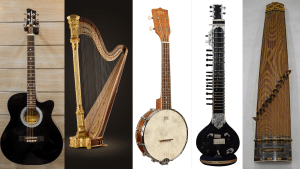
Plucked string instruments make a sound when you pull or pick the strings with your fingers or a pick. They can play both melody and rhythm and are found in many music styles worldwide.
Guitar: The guitar is a popular string instrument with six strings. It can be played by strumming or picking. Guitars are used in many music styles, like rock, blues, country, and pop. They come in acoustic and electric versions with different sounds.
Harp: The harp is a large, upright string instrument with many strings stretched across a frame. It’s played by plucking the strings with fingers. Harps are known for their calm, dreamy sound and are used in classical, folk, and even some modern music.
Banjo: The banjo has a round body and a thin neck with four or five strings. It’s played by plucking or strumming. Known for its sharp, twangy sound, the banjo is common in folk, bluegrass, and country music in the United States.
Sitar: The sitar is a long-necked string instrument from India. It has many strings, including ones that vibrate under the main strings, to add depth. Played while sitting, the sitar makes rich, ringing sounds and is used in Indian classical and spiritual music.
Koto: The koto is a traditional string instrument from Japan. It’s a long, flat wooden board with 13 strings stretched across movable bridges. Played by plucking with fingers or picks, it creates soft, flowing sounds often used in Japanese classical and cultural music.
Struck Strings
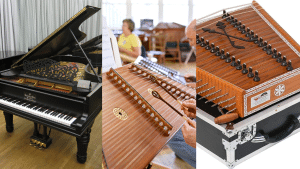
Struck string instruments create sound when their strings are hit, usually with hammers or sticks. They often have keys or surfaces to control the notes and are used in both classical and modern music for their wide range of sounds.
Piano: The piano is a large keyboard instrument. When you press a key, a hammer hits a string inside to make the sound. It’s used in nearly every music style. People love it for its wide range, from soft melodies to powerful chords.
Hammered Dulcimer: The hammered dulcimer is a string instrument with a flat, trapezoid-shaped body. Strings are stretched across it and struck with small hammers. It has a bright, ringing sound. It’s often used in folk music and creates fast, rhythmic tunes with a lively feel.
Santoor: The santoor is a traditional instrument from India and nearby regions. It has a flat wooden body with many strings stretched across it. Played with light wooden sticks, it creates a soft, shimmery sound and is often used in classical Indian music.
2. Woodwind Instruments
Woodwind instruments make a sound when air is blown into or across them. Some use reeds, while others use just a mouthpiece. They can play smooth, sharp, or breathy tones and are found in many music styles, from classical to folk.
Flutes
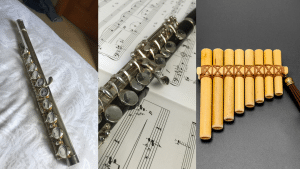
Flutes are woodwind instruments that don’t use reeds. You make a sound by blowing air across a hole. They can be made of metal, wood, or even bamboo. Flutes often have a clear, bright tone and can play both fast and gentle melodies.
Western Flute: The Western flute is a long, metal tube played by blowing across a hole near one end. It has keys to change notes and makes clear, bright sounds. It’s used in classical, jazz, pop, and even movie soundtracks.
Piccolo: The piccolo looks like a tiny flute but sounds much higher. It’s the smallest in the flute family and plays very sharp, bright notes. Often used in orchestras and marching bands, it adds sparkle and power to the music.
Pan Flute: The pan flute is made of tubes of different lengths, usually tied together. Each tube makes a different note when you blow across the top. It’s one of the oldest instruments found in folk music across South America, Asia, and Europe.
Single & Double Reeds
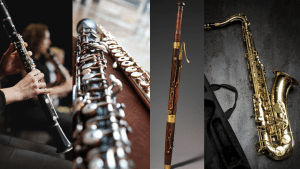
These woodwinds use thin pieces of cane called reeds to make sound. Single-reed instruments, like the clarinet and saxophone, use one reed attached to a mouthpiece. Double reed instruments, like the oboe and bassoon, use two reeds tied together, creating a sharper and more buzzing tone.
Clarinet: The clarinet is a single-reed woodwind with a smooth, deep tone. It’s made of wood or plastic and played by blowing into a mouthpiece. It can play both soft and lively tunes and is used in jazz, classical, and marching bands.
Oboe: The oboe is a double-reed woodwind with a bright, sharp sound. It’s thinner than a clarinet and has a more piercing tone. It’s often used in classical music and leads the orchestra in tuning before a concert starts.
Bassoon: The bassoon is a large, double-reed woodwind with a long, curved shape. It makes deep, warm, and sometimes funny-sounding tones. It’s often used in classical music to add richness to the lower sounds and even plays comical parts in some pieces.
Saxophone: The saxophone is a brass-looking woodwind that uses a single reed like a clarinet. It’s popular in jazz, pop, and marching bands. It comes in different sizes and pitches, from soprano to baritone, and is known for its smooth, bold sound.
3. Folk & Ethnic Woodwinds
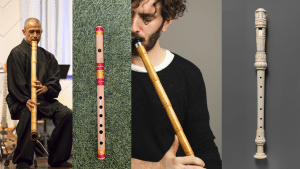
These woodwinds come from different cultures and are often made from natural materials like bamboo, cane, or clay. They have simple shapes but rich, deep meanings in tradition.
Shakuhachi: The shakuhachi is a Japanese bamboo flute played by blowing across the top edge. It has a soft, breathy sound and is often used in Zen music and meditation. It can play both clear notes and airy, emotional tones.
Bansuri: The bansuri is a bamboo flute from India. It’s played sideways by blowing across a hole near one end. It has a smooth, calming sound and is mostly used in Indian classical music to express peaceful or emotional moods.
Ney: The ney is an ancient flute from the Middle East. Made from hollow cane, it’s played by blowing into the top at an angle. It has a soft, breathy sound and is often used in spiritual and traditional music from places like Turkey and Iran.
Recorder: The recorder is a straight, whistle-like flute often made of plastic or wood. It’s played by blowing into the mouthpiece and covering holes with fingers. It’s easy to learn, used in schools, and found in early and folk music around the world.
4. Brass Instruments
Brass instruments are made of metal and played by buzzing your lips into a mouthpiece. They’re known for their loud, bold sound but can also play soft and smooth. Used in bands, orchestras, and jazz, they bring power and color to music.
High Brass
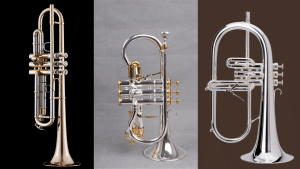
High brass instruments are smaller in size and play higher-pitched notes. They often lead with sharp, bright sounds that cut through other instruments.
Trumpet: The trumpet is a bright, loud brass instrument with three valves. It’s played by buzzing your lips into a small mouthpiece. It’s often heard in jazz, classical, and marching bands, leading with sharp, bold notes and exciting melodies.
Cornet: The cornet looks like a smaller, rounder trumpet. It also has three valves and is played the same way. Its sound is smoother and softer than the trumpet, making it a favorite in brass bands and for solo parts in softer music.
Flugelhorn: The flugelhorn is shaped like a trumpet but has a wider body. This gives it a warmer, deeper sound. It’s used in jazz and brass bands for gentle melodies and mellow tunes. It blends well with other instruments and adds a soft touch.
Low Brass
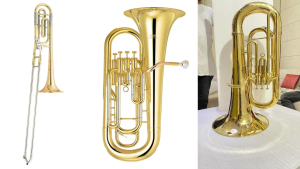
Low brass instruments are bigger and make deep, rich sounds. They play the bass parts and add weight to the music.
Trombone: The trombone is a brass instrument with a long slide instead of valves. Players move the slide to change notes. It has a bold, rich sound and is used in orchestras, jazz bands, and marching bands for both melody and harmony.
Tuba: The tuba is the biggest and lowest-sounding brass instrument. It has valves and a wide bell that faces up or forward. Its deep, heavy sound supports the whole band or orchestra. It’s often used for bass lines and background power.
Euphonium: The euphonium looks like a small tuba and has a smoother, softer sound. It uses valves like the tuba but plays higher notes. It’s used in concert bands, brass bands, and sometimes solos. Its warm tone fills in the middle range.
Other Brass Instruments
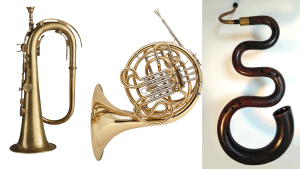
Some brass instruments don’t fit neatly into high or low groups but still have special roles. Some of them are:
Bugle: The bugle is a simple brass instrument with no valves. It makes a sound by changing lip tension. It’s often used in the military for signals like wake-up or lights-out. Its clear, loud tone carries well over long distances.
French Horn: The French horn has a round, coiled shape with a wide bell. It uses valves and has a smooth, mellow tone. Played with one hand inside the bell, it’s used in orchestras for both soft background music and strong, bold sounds.
Serpent: The serpent is an old brass instrument shaped like a long, curved snake. Made of wood or metal and played with a mouthpiece, it has a deep, soft tone. It was used before the tuba in early music and church choirs.
4. Percussion Instruments
Percussion instruments make sound when you hit, shake, or scrape them. They can be tuned to play notes or just make rhythm. From drums to bells, they keep the beat and add texture to music in every style worldwide.
Tuned Percussion
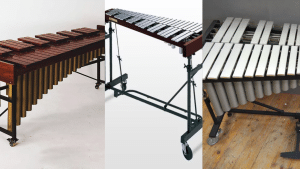
Tuned percussion means the instrument can play clear notes or pitches, just like singing or playing a melody. Each bar, key, or part of the instrument makes a specific sound. These instruments are used not just for rhythm but also for playing actual tunes.
Marimba: The marimba has wooden bars laid out like a keyboard and is played with mallets. Under each bar are tubes that help make a rich, deep sound. It’s used in orchestras, bands, and solo performances for its warm, earthy tones.
Glockenspiel: The glockenspiel has small metal bars arranged like a piano. It’s played with light mallets and makes bright, high-pitched sounds. It’s often used in orchestras, marching bands, and even holiday music for its sharp, bell-like tone that cuts through clearly.
Vibraphone: The vibraphone has metal bars and is played with mallets. It also has rotating fans in the tubes below that create a soft vibrato sound. Common in jazz and classical music, it’s known for its smooth, mellow ringing that gently echoes.
Untuned Percussion
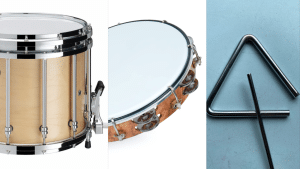
Untuned percussion instruments don’t play specific notes or pitches. Instead, they make sounds used for rhythm, accents, and effects. You can’t play a melody on them, but they’re important for keeping time and adding energy and texture to the music.
Snare Drum: The snare drum has a sharp, crisp sound thanks to metal wires (snares) stretched under its bottom head. Played with sticks, it’s used in marching bands, orchestras, and rock music to keep rhythm and add strong, clear beats.
Tambourine: The tambourine is a small hand-held drum with metal jingles around its edge. You can shake it, tap it, or hit it. It adds sparkle and rhythm to folk, pop, and world music, often played by hand or alongside singing.
Triangle: The triangle is a small metal bar bent into a triangle shape and played by striking it with a metal beater. It has a bright, ringing tone that stands out. It’s used in many music styles to add a light, shimmering sound.
Cultural Percussion
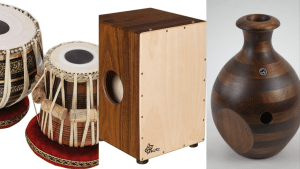
Cultural percussion includes rhythm instruments from different parts of the world. They’re often handmade from natural materials and used in traditional music, dance, and ceremonies. Each one carries a piece of its culture’s story, passed down through sound and rhythm.
Tabla: The tabla is a pair of small drums from India, played with fingers and palms. Each drum has a different size and pitch. It creates fast, detailed rhythms and is often used in Indian classical music and devotional songs.
Cajón: The cajón is a wooden box drum from Peru. You sit on top and hit the front panel with your hands. It gives both bass and snare-like sounds, making it popular in flamenco, Latin, and acoustic music for its full rhythm.
Udu: The Udu is a clay drum from Nigeria shaped like a water jug. It’s played by tapping and sliding fingers on the holes and surface. It makes soft, bubbling, and deep tones, often used in African traditional and calm, earthy music.
5. Keyboard Instruments
Keyboard instruments are played by pressing keys that trigger sounds in different ways. Some strike strings, some push air, and others use electronics. They can play many notes at once, making them great for melody, harmony, and even full songs by one person.
Acoustic Keyboard Instruments
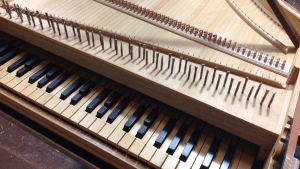
Acoustic keyboard instruments make sound without electricity. They use strings, air, or other natural ways to produce music.
The piano uses hammers to hit strings, giving it a wide range of loud and soft notes. The pipe organ pushes air through pipes to create deep, rich sounds, often heard in churches and big halls.
The harpsichord plucks strings when you press the keys, giving it a sharp, older sound used mostly in early classical music. Each of these instruments has a special role in music history and adds its own voice to different styles and settings.
Digital and Electronic Keyboard Instruments
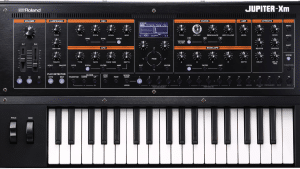
Digital and electronic keyboards use electricity to create sound. Some copy real instruments, while others make brand-new tones. These instruments bring fresh sounds and are often used in modern, pop, and film music.
The synthesizer, or synth, is very flexible. It can sound like a piano, a drum, or even something totally new.
The clavioline is an early electronic keyboard known for its strange, buzzing sound. It was used in pop and rock songs in the mid-1900s.
The celesta looks like a small piano but uses metal plates instead of strings. It has a light, bell-like sound and is often used in magical or gentle music, like in “The Nutcracker.”
6. Rare, Hybrid, and Unusual Instruments
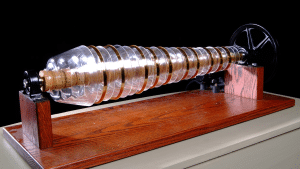
Some instruments mix natural sounds with electronic parts to make something truly different.
The theremin is played without touching it. You move your hands near metal antennas to change pitch and volume. It creates spooky, wavy sounds often heard in sci-fi movies.
The glass armonica uses spinning glass bowls to make sound when touched with wet fingers, but it’s often paired with microphones or effects to boost its soft tone.
The waterphone has metal rods and a water-filled base. You play it with a bow or tap it, and it produces eerie, echo-like sounds perfect for sound effects.
How These Groups Help Us Understand Music
Grouping instruments helps us make sense of the sounds we hear. Each type has its own way of making music. Knowing how they work helps us understand what we’re listening to.
For example, string instruments use vibration, while percussion uses hits and shakes. That changes how each one sounds and feels. These groups also help people learn music faster. If you know the group, you can guess how to play it or what role it has in a band.
It also shows how different cultures use sound. Every group has its own place, whether in a quiet solo or a loud band. Understanding these types helps us listen better and enjoy music more deeply.
Conclusion
So now you and I both know a lot more about the types of musical instruments and what makes each one tick. Next time you hear music, try picking out the sounds and see if you can tell what’s making them.
I do that all the time now, and it makes listening way more fun. Maybe one group or instrument caught your attention. Learn more about it!
The more you understand, the more music means to you. That’s what I’ve found, at least. There’s still a lot to learn, and I’m just getting started too.
If you’re curious like me, check out the other blogs I’ve written. Let’s keep going, click on another post!

